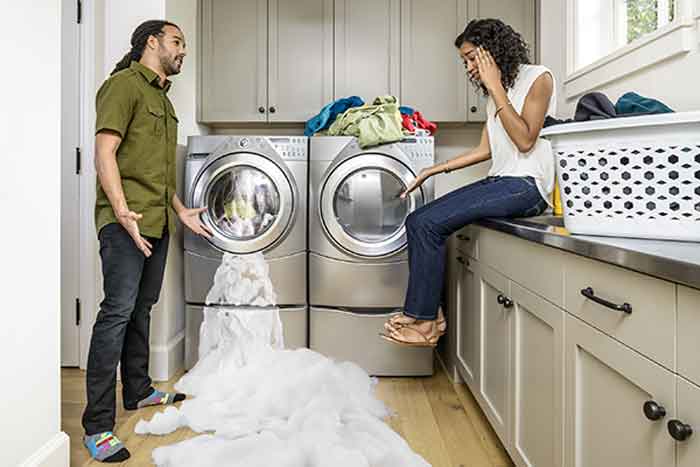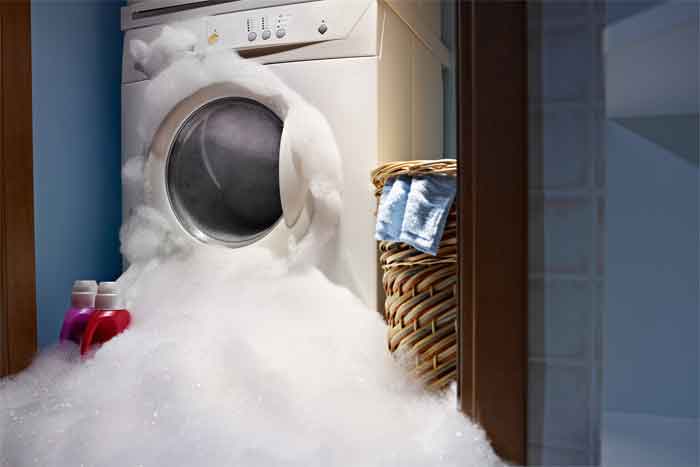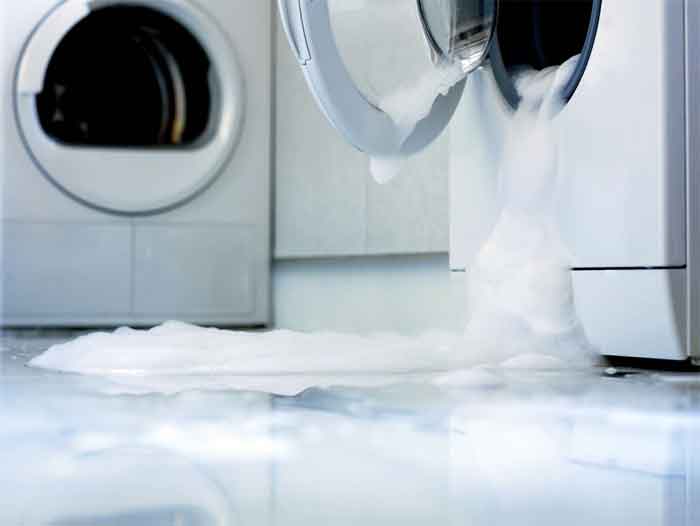Disclaimer: This post may contain affiliate links, meaning we get a small commission if you make a purchase through our links, at no cost to you. For more information, please visit our Disclaimer Page.
Many of us have witnessed or surely seen how it looks like when a washing machine overflows and what kind of mess it creates. You need to admit, it isn’t a pleasant surprise and it leaves your bathroom wet and soapy, right?
In this article, I will explain to you how you can evade this nuisance and which steps you can take to fix this problem.

Washing Machine Overflows
Back in the student days when I was renting an old house with my girlfriend, I came across the same problem.
We left that older-model washing machine up and running and we went for some groceries.
Can you imagine what happened?!
By the time we came back, the whole bathroom floor was covered in soap and there were splashes everywhere. Not to mention the unpleasant odor that came out from behind the washing machine.
Being a student, you can imagine what a bill coming from a plumber could’ve done to our budget. So, we decided to fix this problem on our own.

What Causes a Washing Machine to Overflow?
The first piece of the puzzle is diagnosing the problem. We will cover how you can predict if the overflow is going to hit your bathroom floor in the first place.
Next, we will see how can we DIY this problem and what cheap parts can help us avoid the huge bill coming from a plumber.
Things you should know
It is important to note that the
- Older washing machines were intended to take smaller quantities of water to be able to wash smaller amounts.
- Modern washing machines are intended for washing large amounts of laundry so their drainpipe can bear larger amounts of water.
The point is that if you possess some older washer, its drain pipe cannot bear the larger load i.e. modern amounts of water needed for today’s ’’washing appetites’’.
Also, things you can do to make sure overflowing wouldn’t happen (with the condition that washing machine parts are working properly and error-free):
- Do not overstuff – Don’t do it and make sure to distribute the laundry evenly and broadly.
- Do not put more detergent than it is needed.
- Choose the right detergent – Whether you own older or newer washing machine, detergent with HE mark, meaning High-Efficiency detergents will save you from trouble.
Process of Washing
Let’s see which parts of the washing machine could be causing the overflowing issue.
1. Drain motor pump has the role to push or pull water from the machine. It does that by spinning clockwise or counter-clockwise, depending on which action mentioned above is occurring.
2. All of what is drained is going into the standpipe. The Standpipe is a vertical piece of pipe that prevents the sewerage gas from getting inside the laundry area.
Standpipe has the elbow at the end who is in charge of preventing backflow and overflow from happening. Soon, we will discuss it further.
3. Drain hose, which connects the washing machine with a standpipe is in many cases starting point for dealing with an overflowing issue,
So are you beginning to take a glimpse into our problem? Well, I hope you are.

How to Fix the Overflow
Water level switch or pressure switch is a round object usually found inside the control console on your washing machine. It has few wires on the side and one black hose connected to it, which is meant to regulate the pressure.
First, test the pressure switch.
- Unplug the power from your washer
- Open the lid of the washing machine
- Disconnect the wires going from the pressure switch
- Take the black hose mentioned above and see if there is debris or sediment in it and if it does, be sure to remove it
- Pull up the hose from the bottom and try to blow into it
-If you hear the clicking sound than your pressure switch is doing its job
-if not, then it probably needs replacement
Now, let’s assume that you hear a clicking sound and you still have problems with overflowing.
We will need to test the black tube connected to the pressure switch.
We need to:
- Take it out
- Submerge it in the water
- While keeping one end of the black hose in the water, try blowing through the second end into the hose
- If you see bubbles then it is definitely a case of a faulty hose which has pinholes inside
- Buy a new hose and attach it to the pressure switch
Now, if you didn’t hear the clicking sound (while blowing inside the black hose connected to the pressure switch) then your pressure switch needs replacement. It can be found for $20-30 and it can save you hundreds of dollars coming from a plumber’s bill.
Also, the problem might come from clogged standpipe so we will look into the steps we can take to clean it up:
- Locate the drain hose
- Pull the drain hose free, by squeezing a clip that is holding a drain hose attached to the washing machine
- Remove the other end of the drain hose wherever it is connected to
- Using a metal coat hanger or with the help of auger you should try removing any clog/lint that remained in the hose
- Flush the drain hose with a hot water
- Straighten the hose and inspect if any debris is left
- When you’ve removed the debris, you should reattach the hose back to its place. I recommend using a zip tie to do that and you are good to go
As a final step, I recommend using a system that makes sure that overflow won’t happen and that it can be prevented on time, so it saves you a lot of trouble.
If you decided to use the solution, which the whole purpose is to prevent the washing machine from overflowing (even if you haven’t done any of the steps advised in this article), then overflow protection is a thing for you.
This mechanism detects potential leakage from your washing machine and it makes sure to prevent an overflow.
Conclusion: Washing Machine Overflow
So there you have it. Keeping your bathroom clean and dry is quite important, therefore, make sure to check your washing machine from time to time.
However, you can’t always be sure not to experience something like this, but, you can do some steps in order to prevent it.
Anyway, keep an eye on your washing machine when it works from time to time.
You might also like: How to Unclog a Washing Machine Drain Pipe
